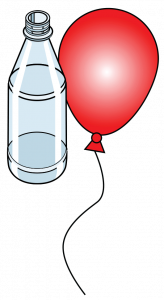Making Methane Advanced Experiment
Print this page to do an experiment about how natural gas forms.
The natural gas we use in our homes is composed mostly of methane that took millions of years to form from decomposing organisms deep underground. You can mimic the natural gas formation process by using decomposing vegetable matter to create biogas.
Biogas is different from natural gas. It contains methane and carbon dioxide, but not the wide variety of hydrocarbons found in natural gas. However, the conditions that create biogas most rapidly in your experiment are the same conditions that were most favorable for the creation of natural gas millions of years ago.

Materials
- 6 identical small-necked bottles (plastic water or soda bottles work well)
- Duct tape
- 6 balloons of the same size and shape
- Funnel
- 1½ cups of soil
- Measuring cup
- 2 cups of a mixture of vegetable scraps and grass clippings
- Permanent marker
Directions
- Mix the soil and vegetable scraps well. Divide up the mixture into six equal portions of a little more than ½ cup each. Put one portion into each bottle.
- Stretch a balloon over the opening of each bottle and secure it with duct tape.
- Use the marker to write on each bottle the level of the mixture. Put the date by your mark.
- Place the bottles upright in the following places. (Be sure to let the adults in your home know what they are for so they won’t be disturbed!)
- In the fridge
- In the freezer
- In direct sunlight
- In artificial light
- Under the kitchen sink
- Near a heat source
Analysis
What was the relationship between the levels of the mixtures and what happened to the balloons?
In which locations did the balloons grow biggest, and why?
In which locations did the balloons grow the least, and why?
Compare your experiment’s results and the conditions that allowed for the formation of natural gas deposits millions of years ago.
Further Research
Do some library or Internet research to find out where and how biogas is made, and what it is used for.

